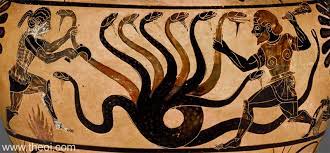Hydra – the greek sea serpent

The Hydra is a nine-headed sea serpent that represents the entrance from Earth to the underworld called Lerna. Her breath, blood, and saliva are poisonous, and her head regenerates when severed. Hydra was the sister of the Chimaera and Cerberus, another terrifying creature created from the union of the parents Typhon and Echidna.

Why he was famous ?
He was a nine-headed sea serpent whose breath, blood, and saliva were so poisonous that even their smell could be deadly. He is most famous in the story of Heracles and his Twelve Labors. Heracles had to atone for the murder of his children by going through a madness sent by the goddess Hera. He served King Eurystheus, who provided him with twelve workers, or tasks, to complete.
Story of Heracles and his Twelve Labors
Heracles’ second labor was to slay the great serpent. He went to the Lerna swamp, which was believed to be the gateway from the earth to the underworld. He attacked the serpent with clubs, and arrows and finally began to cut off its heads; However, whenever he cut off one head, two regenerated in its place. With the help of his nephew Iolos, he set the sticks on fire. Then, each time he cut off the Hydra’s head, he cauterized the wounds with sticks, Which stopped them from growing back.
Hydra had an immortal head
The Hydra had an immortal head, which Heracles hid under a great mountain. They even kept some of the hydra’s poisonous saliva to tip their arrows.
The oldest legend of Hydra
The oldest existing Hydra legend appears in Hesiod’s Theogony, while the earliest images of the monster are found on a pair of bronze fibulae dating from c. 700 BC In both of these sources, the main motif of the Hydra myth is already present: a multi-headed serpent slain by Heracles and Iolaus. While these fibulae depict a six-headed hydra, the number of its heads was first fixed in writing by Alcaeus (c. 600 BC), who gave it nine heads. Simonides, writing a century later, raised the number to fifty, while Euripides, Virgil, and others did not give an exact figure. The paradoxographer Heraclitus rationalized the myth by suggesting that the hydra would have been a one-headed snake with its offspring.

Hydra as constellation
Greek and Roman writers reported that Hera placed the Hydra and the Crab as constellations in the night sky after they were killed by Heracles. When the Sun is in the sign of Cancer (Latin for “crab”), the constellation Hydra is adjacent to its head. Both constellations are derived from earlier Babylonian signs: Bashmu (“The Venomous Snake”) and Alluttu (“The Crayfish”).
Heracles would later use arrows dipped in the poisoned blood of the hydra to kill other enemies during the rest of his labors, such as the Stymphalian bird and the giant Geryon. He later used one to kill the centaur Nessus; and the tainted blood of Nessus was applied to the Tunic of Nessus, by which the centaur took his posthumous revenge. Strabo and Pausanias both report that the foul stench of the Anegrus River in Elis, rendering all fish in the river inedible, was reputed to be due to the poison of the hydra, which was washed away by the arrows of Heracles used on the centaurs.
Heracles’ nephew Iolaus who had handed the firebrand to Heracles, he declared that the labors had not been completed alone and as a result did not count 10 laborers were fixed for it. The mythological element is a similar attempt to resolve a submerged conflict between the ancient Ten Laborers and the more recent Twelve.
